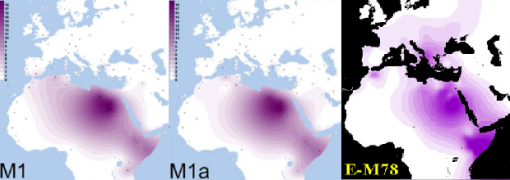The news of the month, kindly posted to me by a friend, is that they have proved via ADNA that the mummy from tomb Kv55 is Akhenaten, son of Amenhotep III and king Tutankhamun’s father, and that the younger lady (KV35) is his mother. It also seems Tut died of malaria and suffered congenital deformities, which I’d guess were the result of incestuous marriages in the royal family. This means that the prior ageing of KV55 as 18 was way off.
This also mean that queen the red-haired queen Tiye (elder lady mummy) was the mother of Kv35 (using logic, they all have the same mt DNA), which might explain why they were found in the same tomb.
I’ve prepared a brief genealogy.


Known grandparents
Amenhotep III and Tiye (whose parents were Tuya and Yuya)


Known parents
Akhenaten (Kv 55) and (KV 35).
The actual name of KV35 uncertain but she has been suggested as Nefertiti, these were brother and sister.

Tutankhamun, who appears to have also married his sister Ankhesenamun.
It would be interesting to see if the mummy in Kv21A is indeed Tut’s wife Ankhesenamun, as she is known to be the daughter of Nefertiti and Akhenaten, and this could give a definitive answer as to whether Kv35 is in fact Nefertiti. Ankhesenamun has been identified as the mother of one of the fetuses from Tut’s tomb, so this might be on the cards for the future.
Ancestry and Pathology in King Tutankhamun’s Family
Zahi Hawass, PhD; Yehia Z. Gad, MD; Somaia Ismail, PhD; Rabab Khairat, MSc; Dina Fathalla, MSc; Naglaa Hasan, MSc; Amal Ahmed, BPharm; Hisham Elleithy, MA; Markus Ball, MSc; Fawzi Gaballah, PhD; Sally Wasef, MSc; Mohamed Fateen, MD; Hany Amer, PhD; Paul Gostner, MD; Ashraf Selim, MD; Albert Zink, PhD; Carsten M. Pusch, PhD
JAMA. 2010;303(7):638-647.
Context
The New Kingdom in ancient Egypt, comprising the 18th, 19th, and 20th dynasties, spanned the mid-16th to the early 11th centuries BC. The late 18th dynasty, which included the reigns of pharaohs Akhenaten and Tutankhamun, was an extraordinary time. The identification of a number of royal mummies from this era, the exact relationships between some members of the royal family, and possible illnesses and causes of death have been matters of debate.
Objectives
To introduce a new approach to molecular and medical Egyptology, to determine familial relationships among 11 royal mummies of the New Kingdom, and to search for pathological features attributable to possible murder, consanguinity, inherited disorders, and infectious diseases.
Design
From September 2007 to October 2009, royal mummies underwent detailed anthropological, radiological, and genetic studies as part of the King Tutankhamun Family Project. Mummies distinct from Tutankhamun’s immediate lineage served as the genetic and morphological reference. To authenticate DNA results, analytical steps were repeated and independently replicated in a second ancient DNA laboratory staffed by a separate group of personnel. Eleven royal mummies dating from circa 1410-1324 BC and suspected of being kindred of Tutankhamun and 5 royal mummies dating to an earlier period, circa 1550-1479 BC, were examined.
Main Outcome Measures
Microsatellite-based haplotypes in the mummies, generational segregation of alleles within possible pedigree variants, and correlation of identified diseases with individual age, archeological evidence, and the written historical record.
Results
Genetic fingerprinting allowed the construction of a 5-generation pedigree of Tutankhamun’s immediate lineage. The KV55 mummy and KV35YL were identified as the parents of Tutankhamun. No signs of gynecomastia and craniosynostoses (eg, Antley-Bixler syndrome) or Marfan syndrome were found, but an accumulation of malformations in Tutankhamun’s family was evident. Several pathologies including Köhler disease II were diagnosed in Tutankhamun; none alone would have caused death. Genetic testing for STEVOR, AMA1, or MSP1 genes specific for Plasmodium falciparum revealed indications of malaria tropica in 4 mummies, including Tutankhamun’s. These results suggest avascular bone necrosis in conjunction with the malarial infection as the most likely cause of death in Tutankhamun. Walking impairment and malarial disease sustained by Tutankhamun is supported by the discovery of canes and an afterlife pharmacy in his tomb.
Conclusion Using a multidisciplinary scientific approach, we showed the feasibility of gathering data on Pharaonic kinship and diseases and speculated about individual causes of death.
According to someone (not me) who has been bothered to enter the Y chr markers as seen on the video, Tut is coming up as R1b. I’d have put money on it being something more like an E1 Y chr, or maybe J as an outside chance…R1b isn’t unknown in Egypt, (see Wood 2005) but isn’t exactly common. R1b appears to have entered Africa from Asia sometime in the Neolithic along with Afro-Asiatic, which is really all I have to say until I get a published source and more detail. Can’t get any detail on the mt DNA, unfortunately.
For anyone interested, there’s a bunch of videos at the Discovery Channel site about this, with some good shots of Akhenaten in his coffin.











![[morocco_tunisia.jpg]](https://i0.wp.com/1.bp.blogspot.com/_Ish7688voT0/Snqpb1qFPpI/AAAAAAAAB7Y/jlu9SZ3yhcM/s1600/morocco_tunisia.jpg)

